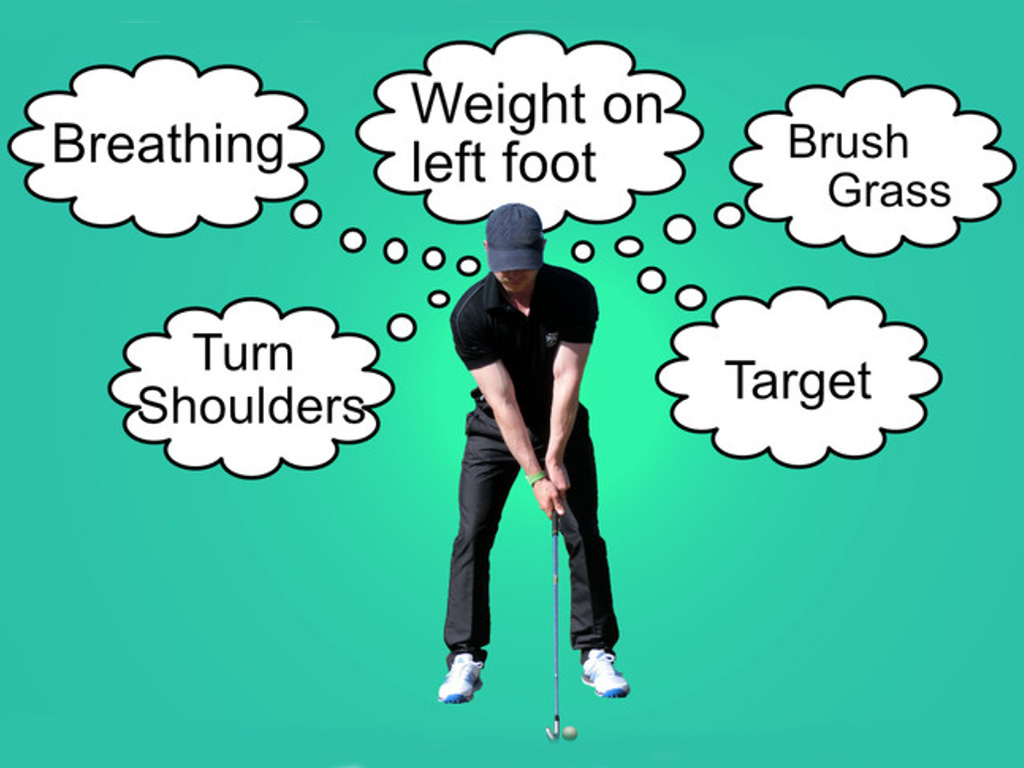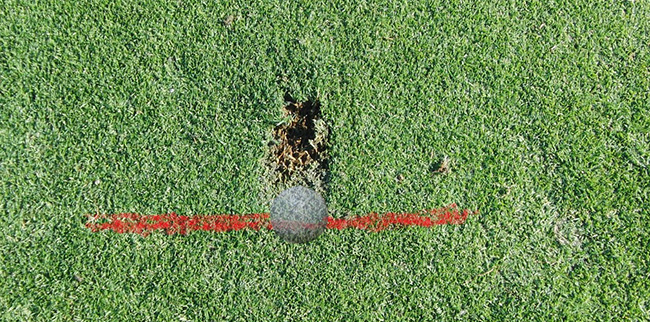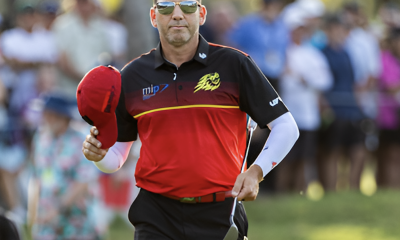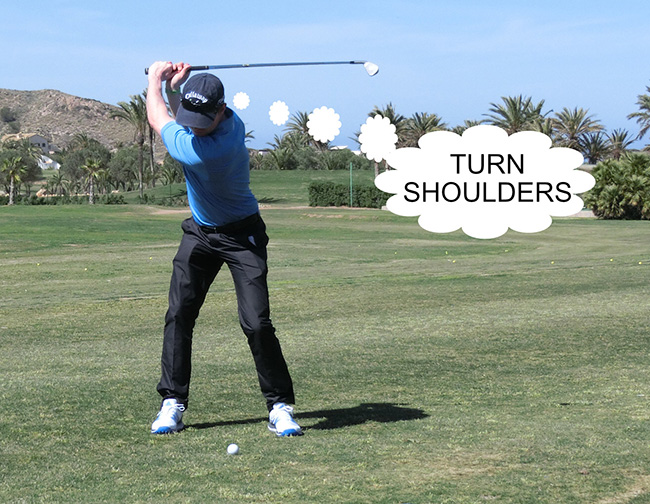Instruction
Finding the right focus for your game

Most golfers work week in, week out on their swing techniques. They search for the perfect mechanics in the hope that, one day, things will fall into place and they will never miss a fairway again.
If you haven’t noticed already, this can’t and won’t happen. There are simply too many variables at play creating optimal performance — and one of the most overlooked areas is where you place your attention.
Example time
To understand this, I will use a relatable example. Imagine you are playing a round of golf, and you are going along pretty well. You are not really thinking of much, and the majority of shots are pretty decent. Then, out of the blue, you hit a stinker.
“You bent your left arm,” shouts your playing partner.
He’s a slightly lower-handicapper than you, so his expertise is obviously warranted (sarcasm). For the next few shots, you become highly aware of your left arm, and your game goes completely down the pan. What happened exactly? Your focus of attention changed.
Loci
While there are many subcategories of these, I will discuss five different types of attention that we could have. Each type of attention has been studied (motor learning science), and has been shown to have variable effects on both learning and performance.
Internal: An internal focus is one that deals with body parts.
- Turn shoulders
- Keep head still
- Shift weight
- Swing my hands to X
While the vast majority of studies show that these types of focus tend to decrease coordination, performance (and slow down learning), they can be of value when we desire a more direct technical change. So, at the right times, these can help to further our techniques — even if it is at the cost of our ability to coordinate movement fluidly.
External Process: The next type of focus is one that is outside of our body, but one which deals with the process of creating a good shot, or a task focus. More what to do than how to do it.
- Making a divot in the right place
- Striking the center of the club face
- Creating a desired swing path/face angle
These focuses tend to be better at coordinating movement to a singular goal, which can dramatically improve shot performance. If a player is suffering from poor distance control, for example, an increased awareness/focus of ground strike quality can create dramatic improvements in results.

Just like focusing on picking up a glass of water (the task) as opposed to the hand/arm movement required, we can also focus on tasks such as divot position, etc.
These focuses tend to be better for handicap golfers and, in my experience, increase long-term skill development. In fact, world-renowned researcher Gabriel Wulf had this to say:
“Over the past 15 years, research on focus of attention has consistently demonstrated that an external focus (i.e., on the movement effect) enhances motor performance and learning relative to an internal focus (i.e., on body movements)”
External result: This focus is, once more, outside of the body. However, it differs from the previous focus in that it deals predominantly with the result.
- Focusing on the shape of shot
- Focusing on the target
- Focusing on the trajectory of the ball
- Focusing on the landing spot
Again, the science shows that these seem to improve our coordination — as if our brains jostle all the moving body parts toward one collective goal. In fact, the research shows that external-result foci can coordinate the body parts in many subtly different ways to achieve the same goal.
However, this effect is normally only seen in tasks which are simple, or tasks which have already been learned. So, for better or elite golfers, focusing on the target may improve performance. However, for a lesser golfer who hasn’t yet ingrained vital impact skills (such as a centered-face strike), it may cause poorer performance.
Neutral: Neutral focuses are very strange, but they are something which doesn’t particularly relate to the task in hand.
- Counting
- Singing in your head
- Humming
- Relaxing your mouth
These act as a conscious distraction, leaving the movement to flow from the subconscious mind. Science has shown that these types of focus can be beneficial for players who have good learned/ingrained skills, yet seem to be unable to bring them out.
So, if you seem to hit the ball really well normally, but crack under pressure, learning to play with a neutral focus may be the key to bringing out your best game. Now, this type of focus may not make you play better than you are capable of doing (this may require one of the previous foci), but it may help you become more pressure resistant and even more consistent if you have good habits ingrained.
For higher handicap players, this type of focus may be detrimental, as they may need to have a higher level of focus on their swing due to it being more of an unlearned skill. However, I have seen neutral foci be beneficial even for complete beginners.
Transcendental: We have all experienced this in one way or another — perhaps not in golf, but in another activity. This is what most label “The Zone.”
Perhaps you were hung-over. Maybe you were short of sleep. But, for whatever reason, you might have played your best ever golf when there was very little thought/focus on the task at hand. Many of the best players report playing their best and unable to recall being “there” during the performance. This is much harder to achieve in golf, as we have too much time to control the entire process. We are much more likely to get into this mind-set during faster-paced, rhythmical activities (such as tennis).
This state of mind is also quite paradoxical, in that the more you try to get into it, the less likely you are to find it. However, I have personally found (with myself and my pupils) that they are better able to get into this high-performing, low-thinking state via training with neutral focuses. When we are able to trust our ability to perform without conscious control, we seem to be able to “let-go” much easier.
Summary
This was a brief look at how where we place our attention can have an effect on our performance, learning and transference of learning (from the range/non-pressured situations to competitions). It is also a look at how players at different levels and with different issues may benefit from a change of mindset.
I use my knowledge of the science, as well as my experience in teaching more than 10,000 hours of lessons, in order to guide players to better focuses for them so they can achieve their best performances, or speed up change (depending on the goal). My online practice programs also go through a testing procedure to hone in on the right focus for the player (CLICK HERE to learn more).
I also discuss these topics and much more in The Practice Manual: The Ultimate Guide for Golfers. The book has been a No. 1 best-seller on Amazon in the U.S., UK, Canada, France and Germany.
- LIKE138
- LEGIT32
- WOW8
- LOL0
- IDHT2
- FLOP1
- OB1
- SHANK4
Instruction
The Wedge Guy: The easiest-to-learn golf basic

My golf learning began with this simple fact – if you don’t have a fundamentally sound hold on the golf club, it is practically impossible for your body to execute a fundamentally sound golf swing. I’m still a big believer that the golf swing is much easier to execute if you begin with the proper hold on the club.
As you might imagine, I come into contact with hundreds of golfers of all skill levels. And it is very rare to see a good player with a bad hold on the golf club. There are some exceptions, for sure, but they are very few and very far between, and they typically have beat so many balls with their poor grip that they’ve found a way to work around it.
The reality of biophysics is that the body moves only in certain ways – and the particulars of the way you hold the golf club can totally prevent a sound swing motion that allows the club to release properly through the impact zone. The wonderful thing is that anyone can learn how to put a fundamentally sound hold on the golf club, and you can practice it anywhere your hands are not otherwise engaged, like watching TV or just sitting and relaxing.
Whether you prefer an overlap, interlock or full-finger (not baseball!) grip on the club, the same fundamentals apply. Here are the major grip faults I see most often, in the order of the frequency:
Mis-aligned hands
By this I mean that the palms of the two hands are not parallel to each other. Too many golfers have a weak left hand and strong right, or vice versa. The easiest way to learn how to hold the club with your palms aligned properly is to grip a plain wooden ruler or yardstick. It forces the hands to align properly and shows you how that feels. If you grip and re-grip a yardstick several times, then grip a club, you’ll see that the learning curve is almost immediate.
The position of the grip in the upper/left hand
I also observe many golfers who have the butt of the grip too far into the heel pad of the upper hand (the left hand for right-handed players). It’s amazing how much easier it is to release the club through the ball if even 1/4-1/2″ of the butt is beyond the left heel pad. Try this yourself to see what I mean. Swing the club freely with just your left hand and notice the difference in its release from when you hold it at the end of the grip, versus gripping down even a half inch.
To help you really understand how this works, go to the range and hit shots with your five-iron gripped down a full inch to make the club the same length as your seven-iron. You will probably see an amazing shot shape difference, and likely not see as much distance loss as you would expect.
Too much lower (right) hand on the club
It seems like almost all golfers of 8-10 handicap or higher have the club too far into the palm of the lower hand, because that feels “good” if you are trying to control the path of the clubhead to the ball. But the golf swing is not an effort to hit at the ball – it is a swing of the club. The proper hold on the club has the grip underneath the pad at the base of the fingers. This will likely feel “weak” to you — like you cannot control the club like that. EXACTLY. You should not be trying to control the club with your lower/master hand.
Gripping too tightly
Nearly all golfers hold the club too tightly, which tenses up the forearms and prevents a proper release of the club through impact. In order for the club to move back and through properly, you must feel that the club is controlled by the last three fingers of the upper hand, and the middle two fingers of the lower hand. If you engage your thumbs and forefingers in “holding” the club, the result will almost always be a grip that is too tight. Try this for yourself. Hold the club in your upper hand only, and squeeze firmly with just the last three fingers, with the forefinger and thumb off the club entirely. You have good control, but your forearms are not tense. Then begin to squeeze down with your thumb and forefinger and observe the tensing of the entire forearm. This is the way we are made, so the key to preventing tenseness in the arms is to hold the club very lightly with the “pinchers” — the thumbs and forefingers.
So, those are what I believe are the four fundamentals of a good grip. Anyone can learn them in their home or office very quickly. There is no easier way to improve your ball striking consistency and add distance than giving more attention to the way you hold the golf club.
More from the Wedge Guy
- The Wedge Guy: Golf mastery begins with your wedge game
- The Wedge Guy: Why golf is 20 times harder than brain surgery
- The Wedge Guy: Musings on the golf ball rollback
- LIKE85
- LEGIT13
- WOW5
- LOL1
- IDHT0
- FLOP4
- OB1
- SHANK8
Instruction
Clement: Stop ripping off your swing with this drill!

Not the dreaded headcover under the armpit drill! As if your body is defective and can’t function by itself! Have you seen how incredible the human machine is with all the incredible feats of agility all kinds of athletes are accomplishing? You think your body is so defective (the good Lord is laughing his head off at you) that it needs a headcover tucked under the armpit so you can swing like T-Rex?
- LIKE0
- LEGIT2
- WOW2
- LOL0
- IDHT0
- FLOP0
- OB0
- SHANK2
Instruction
How a towel can fix your golf swing

This is a classic drill that has been used for decades. However, the world of marketed training aids has grown so much during that time that this simple practice has been virtually forgotten. Because why teach people how to play golf using everyday items when you can create and sell a product that reinforces the same thing? Nevertheless, I am here to give you helpful advice without running to the nearest Edwin Watts or adding something to your Amazon cart.
For the “scoring clubs,” having a solid connection between the arms and body during the swing, especially through impact, is paramount to creating long-lasting consistency. And keeping that connection throughout the swing helps rotate the shoulders more to generate more power to help you hit it farther. So, how does this drill work, and what will your game benefit from it? Well, let’s get into it.
Setup
You can use this for basic chip shots up to complete swings. I use this with every club in my bag, up to a 9 or 8-iron. It’s natural to create incrementally more separation between the arms and body as you progress up the set. So doing this with a high iron or a wood is not recommended.
While you set up to hit a ball, simply tuck the towel underneath both armpits. The length of the towel will determine how tight it will be across your chest but don’t make it so loose that it gets in the way of your vision. After both sides are tucked, make some focused swings, keeping both arms firmly connected to the body during the backswing and follow through. (Note: It’s normal to lose connection on your lead arm during your finishing pose.) When you’re ready, put a ball in the way of those swings and get to work.

Get a Better Shoulder Turn
Many of us struggle to have proper shoulder rotation in our golf swing, especially during long layoffs. Making a swing that is all arms and no shoulders is a surefire way to have less control with wedges and less distance with full swings. Notice how I can get in a similar-looking position in both 60° wedge photos. However, one is weak and uncontrollable, while the other is strong and connected. One allows me to use my larger muscles to create my swing, and one doesn’t. The follow-through is another critical point where having a good connection, as well as solid shoulder rotation, is a must. This drill is great for those who tend to have a “chicken wing” form in their lead arm, which happens when it becomes separated from the body through impact.
In full swings, getting your shoulders to rotate in your golf swing is a great way to reinforce proper weight distribution. If your swing is all arms, it’s much harder to get your weight to naturally shift to the inside part of your trail foot in the backswing. Sure, you could make the mistake of “sliding” to get weight on your back foot, but that doesn’t fix the issue. You must turn into your trial leg to generate power. Additionally, look at the difference in separation between my hands and my head in the 8-iron examples. The green picture has more separation and has my hands lower. This will help me lessen my angle of attack and make it easier to hit the inside part of the golf ball, rather than the over-the-top move that the other picture produces.


Stay Better Connected in the Backswing
When you don’t keep everything in your upper body working as one, getting to a good spot at the top of your swing is very hard to do. It would take impeccable timing along with great hand-eye coordination to hit quality shots with any sort of regularity if the arms are working separately from the body.
Notice in the red pictures of both my 60-degree wedge and 8-iron how high my hands are and the fact you can clearly see my shoulder through the gap in my arms. That has happened because the right arm, just above my elbow, has become totally disconnected from my body. That separation causes me to lift my hands as well as lose some of the extension in my left arm. This has been corrected in the green pictures by using this drill to reinforce that connection. It will also make you focus on keeping the lead arm close to your body as well. Because the moment either one loses that relationship, the towel falls.


Conclusion
I have been diligent this year in finding a few drills that target some of the issues that plague my golf game; either by simply forgetting fundamental things or by coming to terms with the faults that have bitten me my whole career. I have found that having a few drills to fall back on to reinforce certain feelings helps me find my game a little easier, and the “towel drill” is most definitely one of them.
- LIKE12
- LEGIT2
- WOW2
- LOL0
- IDHT0
- FLOP2
- OB0
- SHANK8
-

 19th Hole6 days ago
19th Hole6 days agoDave Portnoy places monstrous outright bet for the 2024 Masters
-

 19th Hole2 weeks ago
19th Hole2 weeks agoThings got heated at the Houston Open between Tony Finau and Alejandro Tosti. Here’s why
-

 19th Hole7 days ago
19th Hole7 days agoTiger Woods arrives at 2024 Masters equipped with a putter that may surprise you
-

 19th Hole2 weeks ago
19th Hole2 weeks agoReport: Tiger Woods has ‘eliminated sex’ in preparation for the 2024 Masters
-

 19th Hole1 day ago
19th Hole1 day agoTwo star names reportedly blanked Jon Rahm all week at the Masters
-

 19th Hole2 weeks ago
19th Hole2 weeks agoAddiction, spinal fusion, and scam artists – Everything Anthony Kim revealed in candid interview with David Feherty
-

 19th Hole2 weeks ago
19th Hole2 weeks agoAnthony Kim says doctors told him that he ‘may not have much time left’ ahead of LIV return
-

 19th Hole1 week ago
19th Hole1 week agoBrooks Koepka and Sergio Garcia make significant equipment changes as 2024 Masters looms




















Locatelli Rao
Jul 5, 2016 at 11:07 pm
Hi there,
In your description under “External Process”, it reads:
“These focuses tend to be better for handicap golfers and, in my experience, increase long-term skill development. In fact, world-renowned researcher Gabriel Wulf had this to say:”
should it read:
“better for (high) handicap golfers”?
Thanks!
Steven
Jul 5, 2016 at 3:39 pm
Great article. These are instruction articles, and since high handicappers need the most instruction, that is probably why more articles are aimed at them. Also, research into learning has developed significantly over the past few years. Helping someone figure out how to learn, or how to focus, can have a large impact on scores. Learning theory is starting to show that what may seem intuitive doesn’t quite work. For example, many people, even in academia, believe individuals have a dominant learning style, so teaching to that style helps them the most. However, recent studies are showing having students use non-dominant learning styles leads to deep learning because it takes more work. I hope golf instructors keep passing on the new cognitive theories to help every day golfers.
Adam Young
Jul 9, 2016 at 3:46 pm
Good points Steven. I have found similar things to what you suggest. I will be doing future articles on how to find the best focus for yourself depending upon your goal (maximizing learning or performance).
tlmck
Jul 4, 2016 at 5:16 pm
I step up to the ball, hit it, go find it, hit it again… Shoot even par. Go home and have a nice glass of iced tea.
Adam Young
Jul 9, 2016 at 3:45 pm
Sounds like a transcendental focus to me. More people play better with that style of focus than you would imagine. Many golfers pull themselves out of it by a belief that they need to control their movement consciously.
Jack
Jul 3, 2016 at 11:26 pm
The good players that I know get new clubs too, but definitely not needing the latest and greatest since it’s more important to know your clubs and there really hasn’t been much improvement since 2012 for better player irons (like the AP2). Drivers meh. It’s more personal preference. Same thing just find the right driver for you doesn’t have to be a M2 or M1. High handicappers waste money because they don’t practice enough and those clubs just sit there.
Anti-M Smuzzle
Jul 3, 2016 at 4:06 pm
Need more articles targeting 16+ handicappers.
\_/
Jul 4, 2016 at 12:08 am
Smozzle
Jul 4, 2016 at 8:22 am
V plane?